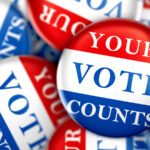October’s Hottest Trend: Voting Early
Election Day is still a few weeks away, but millions of Americans have already cast their ballots. Some have voted by mail, while others have chosen to vote in-person at early voting centers. But those who are showing up to early voting centers are often facing lines up to several hours long. Are the lines an indication of voter enthusiasm, a poorly-designed early voting system, or something else? Here, Election Central takes a closer look.
Why Vote Early?
While members of both political parties vote early, Democrats are more likely to encourage early voting than Republicans. That’s because data shows that more registered Democrats includes people without access to public transportation, people who work second- or third-shift jobs, single parents, and people of color who live in communities where there may be limited access to the polls. Early voting gives these groups more opportunities and more flexible options to vote according to their schedule.
Plus, for political campaigns, early voting offers another advantage. How you vote is private, but whether you vote is part of the public record. This means that once you cast your ballot, both parties know it and can stop trying to persuade you. The campaigns may reroute campaign materials and volunteer hours toward folks who have not voted early.
Why the Long Lines?
About two Democrats to every Republican choose to vote early for the reasons already discussed. So this year’s higher turnout among early voters may be tied to the Democratic Party’s focus on defeating Donald Trump’s reelection attempt. There is also this year’s fears over the coronavirus pandemic, which have people nervous about standing in long lines at crowded polls on Election Day. So far the data shows that more than 15 million people of both political parties have decided to vote early. That’s a historic high.
There are also other reasons for the long lines—a limited number of early voting centers. This means that the people who choose to cast their ballots early may face long lines–that get even longer to maintain social distancing rules. But not everyone can afford to wait for hours in line. (In some of Georgia’s early voting locations the wait to vote last week was as long as eleven hours.)
Does the Early Turnout Mean Anything?
While it’s much more likely that Democrats will win the early vote, Republicans say that they will come out in greater numbers to vote for Trump and the other Republican candidates on Election Day. Political experts are quick to point out, though, that this strategy can be risky. There’s no telling what can happen on Election Day, and anything from an unexpected weather event, to illness, to being called into work can prevent a person from casting her ballot. Plus, there’s always the chance that a candidate could say or do something at the last minute to change a voter’s mind. Voting early means that no matter what happens between now and Election Day, your ballot has been cast.



